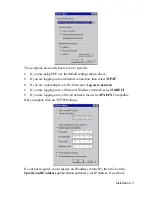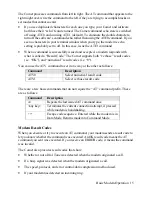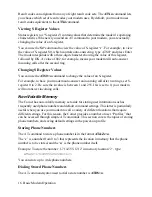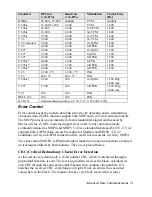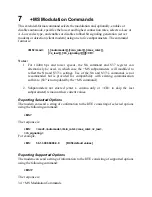
Advanced Data Communications 23
Hardware or Software Flow Control
Flow control determines how data will be transferred between your computer and
modem. Your modem supports two flow control methods. But regardless of which flow
control method you use, make sure your communications software is configured to use
the same flow control method that your modem is using. Otherwise, you may experience
erratic data transfer where portions of received data are lost, or you will receive
frequent errors during data transfers.
The flow control option is set by AT&Kn as follows:
&K0
Disables flow control.
&K3
Enables CTS/RTS flow control.
&K4
Enables XON/XOFF DTE/DCE flow control.
&K5
Enables transparent XON/XOFF DTE/DCE flow control.
&K6
Enables CTS/RTS and XON/XOFF DTE/DCE flow control. (default)
Hardware CTS/RTS
This is a bi-directional flow control where CTS and RTS are RS232 signals which
must be available on your computer. When the modem's transmission buffer is almost
full, the modem will drop CTS to signal the DTE that it cannot accept any more data.
Turn ON the CTS to notify the DTE that it can keep sending data to the modem. On the
computer software side, when the receiving buffer of the software is almost full, it will
drop RTS to signal the modem to stop sending data to the DTE. Turn ON the RTS and
the modem will start sending data again to the DTE. In asynchronous full-duplex
applications, the Comet always responds to the RTS signal as a flow control signal. The
Comet defaults automatically to this hardware flow control setting and it is a better
choice.
Software XON/XOFF
This is a bi-directional flow control. XON and XOFF character defaults are decimals
17 and 19. Both the modem and the DTE will treat XOFF as a signal to stop transmitting
data, and will treat XON as a signal to restart sending data. Modems will not send these
characters received from the local DTE to the remote modem.
Summary of Contents for Comet 3356
Page 1: ...Comet 3356 User s Manual Version 1 0 JiH5 66 1 7 17 51 7 1 175 1 7...
Page 9: ...2 Introduction...
Page 25: ...18 Basic Modem Operation...
Page 34: ...Special Functions 27...
Page 46: ...MS Modulation Commands 39...
Page 60: ...Fax Operation 53...

